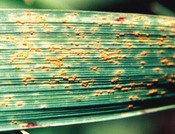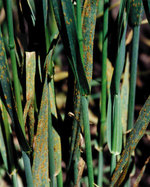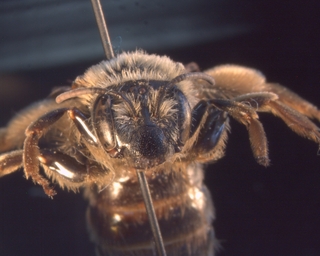|
|
Hello, all! This is Denise. =D =D
Lani and I are starting our posters. We’re doing one that targets the field work and one that targets the lab work. We’re hoping to fill it up with mostly photos like this:

Since I got back, I’ve been staying at Carey’s house. His step-mom has a garden, and guess what I recognized? ECHINACEA! Loads and loads. ^o^ Anyway, we saw a sickly plant in her garden and were hoping for some feedback as to what it could be. There’s some discoloration on the leaves and the heads don’t look too healthy as well. Here are some photos:



=( Unhappy echinacea, yes. What could it be?
Here are some other plants from another part of her garden that look much better:

^_^
Team Echinacea:
A grad student, Emme Bruns, from UMN is studying crown rust. She has been noticing heavy infections of rust on some of the Bromus and Elytrigia (Agropyron) grasses around the twin cities and was wondering if similar infections are occurring up here.
Have you seen anything that looks like a rust pathogen on either of these species?
 
If the pathogen is present, she would like to visit to survey disease incidence and collect isolates.
Let me know if you see anything like this–and make a mental note or note in your visor where you see it.
Thanks!

Last week’s scandal recedes from the public eye following the disappearance of two bees from the south end in broad daylight on Thursday. Common Garden residents are now locking their doors and speculating about the identity of the killer in their midst. Well….. not all of them.
Hi all,
Lani, Denise and I are back in Chicago safe and sound. After such a rainy start to the day overall the drive was smooth and even included a Disney sing along. My reunion with my puppy, Raven, was filled with lots of jumping and tail wagging.

Photo of Raven from before I left for Minnesota…tried to take one tonight but she was too hyper.
Ben, Lecia, and Julie, I had a great time working with all of you and I wish you the best of luck in your future ecological endeavors. Everyone else I will see you back in Chicago or in Minnesota in the near future. Have a great rest of the summer Team Echinacea and we will keep you posted on our progress here in Chicago.
Jennifer
Project pollinator competition is going well, although it has had its issues, mostly involving my camera/pole/counterweight apparatus. I have chosen my plants and four sites, all roadside: Nessman, Railroad Cross, East Elk Lake Road, and Northwest of Landfill. I am surveying plants that have flowered synchronously except for Nessman where I can survey the entire population. In total, I will record data for about 26 plants and 33 heads.
It was very difficult to get my camera high enough to get a 3 m radius around the plants. Hence, I will be taking multiple pictures of each plant to try to get the distances from the potential competitors to the Echinacea. I’ve done some test shots in the field, and using 1m white “x”s made previously by the kite team has helped a lot to orient myself in the photos and to see how many pixels (not “pickles” like I said to a friend on the phone) are in a meter in each picture. I shot pictures for one of my study plants at Railroad Crossing and also took field measurements for distances from one plant to the other. I repeated the measurements with ImageJ and found that there is only a 2-6% difference in the methods, so I can use them interchangeably! I’m super pumped! This makes much more sense for sites that have few surrounding plants.

A couple plants at East Elk Lake Road. Each of the Xs are uniquely marked, and the cardboard next to the plant is its tag number.
Today, Lecia and I went out to take field measurements. We measured the distances to each potential competitor and the number of florets on those competitors. We used this method for all of the plants at East Elk Lake Road and Railroad Crossing because the competitors are not as dense. But not to worry, for Nessman and Northwest of Landfill I will use the aerial photography. I counted style persistence on all of my plants except for Nessman, which Ben and I did two days ago. Neither are ready for the cameras yet, since some of the Nessman plants have yet to flower and the NWL plants are only on their second day.
Stuart asked for a timeline:
Tuesday (Jul 22nd): Morning or afternoon: take someone who can drive stick with me to nessman and nwlf to take photos, also take style persistence data at all four sites.
Wednesday(Jul 23rd): Morning or afternoon: If we don’t get all of the photos that we need, I want to go out the next day to make sure that all of my measurements are available on the photos.
Friday (July 25th): I need an hour or two myself to take style persistence data.
Monday (July 28th): Also style persistence data (1-2 hours alone)
Thursday (July 31st): more style persistence
Monday (Aug 4th): style persistence
etc. until all of the Nessman plants are done flowering. I can analyze data/pictures on rainy days and on my own time.
Thats the plan!
Today marks the halfway point for the summer. Five weeks down, five to go. We’ve accomplished a lot and much more remains. After a long afternoon of measuring plants, we had some watermelon and carbonated beverages to cool off, mark the 1/2way, and wish the Chicagoans well.
Three of our team members are leaving tomorrow for Chicago (Jennifer, Lani & Denise). They will keep us posted about the analysis of the bee-tracking field data and how it relates to their pollen flow study.
Here’s a photo of us on the porch of the Hjelm house today, just after lunch.

Lecia, Ben, Megan, Christine, Denise & Gretel
Julie, Jennifer, Lani. Amy & Stuart.
We had a slow start to the flowering of Echinacea in the common garden for the 2008 season. Being one who gets excited about the abundance of Echinacea heads, I’m pleased to post the numbers of plants and flowering heads so far.
The total number of plants flowering in the common garden as of 17 July 2008 (which is sure to increase as we find more hiding in the tall brome or decrease as they are grazed by deer):
1027
The total number of flowering heads identified as of 17 July 2008 (many still just buds):
1868
As of 17 July 2008:
447 of the 1868 have started to flower. (They are still far from peak flowering!)
Here is a graph showing the number of heads that started to flower on each day.

It was an exciting day on the prairie. After a soaking morning rain, it felt hot and steamy. Just before noon the plants started flaunting their pollen and the bees took advantage. There was plant sex and bee sex and Team Echinacea jumped into the fray trying to keep up with the frenzied activity. Every team-member broke a sweat trying to keep up with all the bees. It was a crazy scene and the excitement in the air was palpable. The bees eventually outmaneuvered and outlasted us, but we had a great time. We left around 12:50 looking forward to another exciting day.

Unlike most of the shy bees, this rascal loved the cameras. She gave quite a show flying from head to head, daring us to follow. We caught her here spreading pollen all over her legs.
I just posted photos of prairie insect specimens from our collection, including many bees that pollinate Echinacea. Enjoy!
Here’s a photo of a specimen of Andrena rudbeckiae (Female). Click to enlarge.

So, there is a lot more to do to improve the web interface to these photos. Let me know your suggestions!
The pages are static html right now. Bianca, CBG science web design hero, made a dynamic version using MySQL and PHP. Her way is the way to go. However we don’t have a good permanent home for a MySQL database: UMN won’t allow phpMyAdmin, Bianca’s software of choice. And CBG doesn’t really support websites for scientists (yet).
More photos will follow and we’ll post more info for each specimen too. I hope to make these update when we have a dynamic, public site, but wanted to get something out now because I am submitting a paper that refers to these specimens.
|
|






